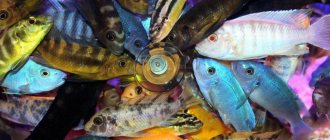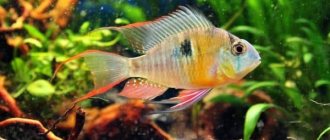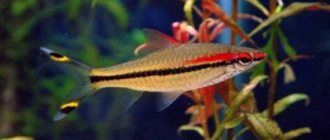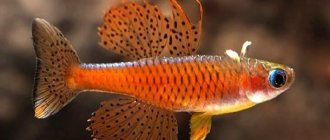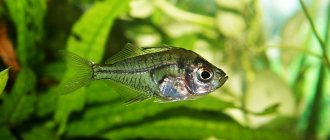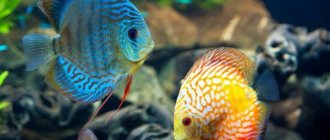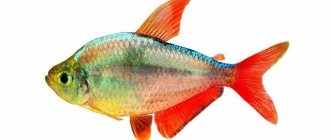Daphnia is a species of crustacean in the Daphnidae family. This genus of small crustaceans is widespread in Europe, America and Australia. Representatives of some species live up to 150 days.
Crustaceans are widely used in aquarium farming. Daphnia in an aquarium serves as a universal food for many species of fish and other underwater inhabitants.
What is Daphnia
Common daphnia is a small crustacean. Thanks to its movement in sharp jerks, it received a second name - water flea.
Depending on the type, sizes can range from 0.2 mm to 6 mm. Large species reach the size of a small pea and can be seen without a microscope.
When magnified, the structure of the crustacean is clearly visible. The body of daphnia is slightly flattened on the sides and has an oval shape. On top it is dressed in a bicuspid leathery shell - the carapace, which ends in a tail needle and protects the internal organs.
Head
The head is covered with a hard chitinous covering. On it there is a beak-like outgrowth - the rostrum, under which there are short anterior antennae - antennules, which perform an olfactory function thanks to the short outgrowths with olfactory setae located on them. The posterior antennae are longer and covered with projections. They help daphnia move through the water column by making leaps.
Crustaceans have five pairs of legs of a complex structure. The thoracic legs of daphnia perform the main functions of respiration and nutrition. They are located on the head. Within one minute, the crustacean makes up to 500 strokes, passing through itself unicellular algae and bacteria suspended in the water. On the limbs there are gill sacs, which are filled with oxygen when they move.
Organ of vision
Daphnia have a paired organ of vision, which is double in mature individuals. Large compound eye, consists of 22 facets. In some species the number of facets can reach three hundred. Below the compound eye is the nauplial ocellus.
When magnifying the daphnia, the internal organs are clearly visible in the photo. The intestinal canal extends from the mouth opening. On the back side there is a pulsating heart. In females, between the body and the dorsal shell there is a brood chamber in which the eggs are located.
Where does daphnia live?
Photo: Daphnia magna
Representatives of the genus can be found almost throughout the Earth. They were even discovered in Antarctica in samples taken from relict subglacial lakes. This means that daphnia are capable of living in almost any natural environment present on our planet.
However, if a century ago it was believed that all their species were distributed everywhere, then it was found that each of them has its own range. In many species they are quite wide and include several continents, but still there is not one that is widespread everywhere.
They inhabit the Earth unevenly, preferring weather conditions in the subtropics and temperate zones. There are noticeably fewer of them both at the poles of the planet and near the equator, in a tropical climate. The ranges of some species have undergone significant changes very recently due to their spread by humans.
For example, the species Daphnia ambigua came from America to Great Britain and successfully took root. On the contrary, the species Daphnia lumholtzi was brought to North America from Europe and became common in the water bodies of this continent.
Water bodies without current, such as ponds or lakes, are preferred for daphnia habitat. They often live in large puddles. There are far fewer of them in slow-flowing rivers, and they are almost never found in fast-flowing rivers. Most species live in fresh water.
But the ability to adapt was also evident here: daphnia, which once found themselves in arid conditions, where only salty bodies of water were available to them, did not die, but developed resistance. Now the species descended from them are characterized by a preference for water bodies with a high salt content.
They live best in clean water - it should contain as little groundwater as possible. After all, daphnia feed by filtering water and, if it is dirty, soil particles get into their stomach along with microorganisms, which means that in polluted water bodies they die much faster due to clogging of the stomach.
Therefore, by the number of daphnia in a reservoir, one can judge how clean the water is. They live mainly in the water column, and some species even live at the bottom. They do not like bright lighting and go deeper when the sun begins to shine directly on the water.
Places and living conditions
These cladocerans can be found in all ponds and lakes in different parts of the world.
Character and lifestyle
Large accumulations of crustaceans are observed in temporary reservoirs - ditches, puddles, small lakes with stagnant water. Getting into water even with a weak current, daphnia filter suspended particles of soil and clog the intestines. This makes it difficult for them to move and causes their death.
Crayfish spend most of their lives in the water column. Some species, filtering water, feed on microscopic algae, while others live near the bottom and eat dead particles of plants and invertebrates. Some varieties, halophiles, easily tolerate drought by hibernating.
These creatures are very voracious. The daily volume of food consumed can reach 600% of their own weight. Daphnia's main diet consists of bacteria, yeast and blue-green algae. The largest concentrations of crustaceans are observed in reservoirs with “blooming” water, where they reproduce especially intensively.
Daphnia reacts sharply to lighting. In bright light, it tries to stay closer to the bottom of the reservoir.
What does daphnia eat?
Photo: Daphnia in the aquarium
In their diet:
- ciliates;
- seaweed;
- bacteria;
- detritus;
- other microorganisms floating in water or lying on the bottom.
They feed by filtering water, for which they move their legs, causing it to flow. Filtration of the incoming water flow is carried out by special fans on filter bristles. The absorbed particles are then clumped together due to secretion processing and sent to the digestive system.
Daphnia is notable for its gluttony: in just one day, some species eat 6 times their own weight. Therefore, when the amount of food decreases, there are fewer of them in the reservoir - this happens with the onset of cold weather, but the largest number of daphnia appears in late spring and summer.
Those species of daphnia that do not hibernate in winter feed on detritus. They spend the winter at the bottom of the reservoir and in layers of water close to it - the food there is dominated by detritus, that is, particles of tissue or secretions of other living organisms.
They themselves are used as food for fish in an aquarium - they are very useful due to the fact that their stomachs contain a lot of plant food. Daphnia are either given dry or released alive into the aquarium. The latter is also useful if the water in it becomes cloudy: daphnia eat the bacteria that cause this to happen, and fish, in turn, eat daphnia.
Appearance
Sex differences
Under favorable conditions, daphnia do not have males. Females give birth to their own kind. When conditions change, some females give birth to males.
Female and male individuals have some differences in external and internal structure:
- females are larger in size;
- on the head shield and outer cover of females there is a pattern of rhombuses and polygons, which is clearly visible when magnified;
- The first and second pairs of legs in males have hook-shaped projections that allow them to cling to females during mating.
Subspecies
About 150 species of these crustaceans live in natural conditions . Very often, several dozen species of crustaceans live in one body of water.
Daphnia magna
This variety is used as live food for aquarium fish due to its high nutritional value. The body length of the female is 3-5 mm, the male – no more than 2 mm. Newborns are microscopic in size. The main color of the outer cover is yellow or pinkish-orange. This species easily tolerates low temperatures. It is quite rare in nature, but in permanent habitats it is found in abundance. The lifespan of adult specimens is 3 months.
Daphnia pulex
The length of an adult female does not exceed 4 mm, a male – 1.5 mm. The color of the outer covers varies from light yellow to red. Externally, the crustaceans resemble Daphnia magna. The difference lies in their smaller size and life expectancy, which does not exceed one and a half months. The variety is characterized by incredible fertility. Females lay eggs every five days. Each clutch consists of 15 eggs.
Origin of the species and description
Photo: Daphnia
The genus Daphnia was described in 1785 by O.F. Muller. There are about 50 species of Daphnia, and many of them have significant differences from others. Daphnia longispina, described by the same Müller, is used as the type species.
Daphnia is divided into two large subgenera - Daphnia proper and Ctenodaphnia. The latter differ in a number of characteristics, for example, the presence of a notch in the head shield, and in general have a more primitive structure. But this does not mean that they occurred earlier: fossils date the origin of both to approximately the same time.
Video: Daphnia
The first representatives of branchiopods appeared about 550 million years ago, among them were the ancestors of daphnia. But they themselves arose much later: the oldest fossil remains date back to the Lower Jurassic period - that is, they are approximately 180-200 million years old.
These are not as ancient times as one might expect from relatively simple organisms - for example, fish and birds appeared much earlier. But, like other representatives of the superorder Cladocera, even in those days daphnia were similar to those of today, and in this they differ from more highly organized organisms of the same antiquity.
At the same time, one should not think that daphnia do not evolve: on the contrary, they have high evolutionary variability and adaptability, and constantly give rise to new species. The final formation of the Daphnia genus occurred immediately after the extinction at the end of the Cretaceous period.
Benefits and harms for the aquarium
These are useful creatures that filter water and regulate the microflora of the aquarium. They serve as live food for many inhabitants of the home pond.
The water flea is not capable of biting a person or harming aquarium fish, since crustaceans do not have a piercing-sucking oral cavity. Allegations regarding bites are fictional.
The main harm of copepods is associated with their high allergenicity. An allergic reaction is caused by the dusty suspension obtained when they are dried for use as dry food.
When dust particles enter a person, an allergic reaction may begin, accompanied by a dry cough, redness of the eyes, excessive lacrimation, runny nose, and exacerbation of bronchial asthma. After some time, a skin rash, itching, and burning appears.
To treat allergies, you should immediately seek medical help or take an antihistamine.
Value as fish food
The water flea is very often used as food for aquarium inhabitants. Crayfish contain up to 70% protein. It is given to fish in dry, fresh or frozen form. Crustaceans are caught in reservoirs or bred at home.
Daphnia as fish food
Due to its high nutrient content, daphnia is an excellent food for aquarium inhabitants. It is quite difficult to breed it under artificial conditions, so it is purchased in pet stores in live, frozen or dried form. In an aquarium, daphnia serves as excellent food for small or young fish. Dried crustaceans are completely ready for consumption; frozen daphnia are packaged in blisters and sold in pet stores. Eating crustaceans has a great effect on aquarium inhabitants. 50% of the weight of the crustacean consists of high levels of proteins. Its calorie content is similar to bloodworms, gammarus, caddisflies, amphipods, cyclops, and pond snails, but daphnia contains a high level of protein.
To breed daphnia in an aquarium you need the following:
- Select a special glass container that will hold from 1 to 3 liters, wash it thoroughly, and do not use abrasive substances.
- The water must be purified and free of chlorine and chemical impurities.
- The required water hardness should be from 5 to 17 degrees, pH from 7 to 8.
- An aquarium with daphnia must be kept away from direct light. The crustacean does not grow well in strong light. Using a 20-volt fluorescent lamp, you need to provide it with natural light throughout the day.
- The water temperature should be between 20 and 24 degrees. If the water is colder, it will not be able to reproduce.
Daphnia in the aquarium must be fully fed, dissolve the fertilizer in the water until it becomes cloudy, then add a new portion.
It is worth thoroughly cleaning the walls of the aquarium and changing the water if necessary. Oxygen must be supplied to the aquarium.
Daphnia is purchased in the form of eggs, then released into a container. When the eggs are ripe, they are caught using a net and used as feed, dried or frozen.
How to catch it from reservoirs yourself
Daphnia is caught from the end of spring until the end of autumn, until the reservoirs are covered with ice. It is recommended to catch in the morning or evening in cloudy, windless weather. In such conditions they rise closer to the surface of the water. For fishing, you can use a regular fabric net.
Caught specimens should be placed in a tin container and shaken periodically. It should be remembered that at high densities they may die during transportation. At home, the crustaceans are washed and passed through a sieve to sort by size.
Distribution and habitat of Daphnia Magna
Daphnia Magna is widespread in the Northern Hemisphere and especially in the Holarctic, subpolar regions and South Africa. It can be found in fresh and brackish bodies of water of varying sizes, from lakes to ponds and ephemeral rock pools by the sea.
The Holarctic, or Holarctic region , is a biogeographic region. Covers most of the Northern Hemisphere and is the largest of all biogeographic regions.
Ephemeral - temporary, existing only for a short time.
Holarctic.
Distribution of Daphnia magna. The upper limit of Daphnia Magna's tolerance to salinity is 4 to 8 ppt. Growth and reproduction were highest at a salinity of 4 ppt. Salinity of 8 ppt caused a significant reduction in growth and reproduction, in addition to reduced oxygen consumption and lower ammonium excretion.
Excretion is the process of releasing the body from the end products of metabolism - excrement.
Daphnia Magna has been found in ditches, shallow ponds and small eutrophic bodies of water that are prone to drying out.
Eutrophication is the saturation of water bodies with nutrients, accompanied by an increase in the biological productivity of water basins. The main chemical elements that contribute to eutrophication are phosphorus and nitrogen. In some cases, the term “hypertrophization” is used.
Breeding at home
Breeding crustaceans is not difficult. To do this, it is enough to create suitable conditions.
Containers for growing
To grow crustaceans at home, you can use containers with a volume of up to 20 liters, made of glass, propylene or stainless steel. If they are raised in a regular aquarium, the surface area must be large to allow for gas exchange.
Environment Settings
Daphnia can be grown in almost any conditions.
Crawfish feel most comfortable in water with the following parameters:
- Temperature. The water flea thrives in a body of water with a wide temperature range. The optimal water temperature is 18-24 degrees.
- Salinity. Daphnia is a freshwater crustacean, so the water in the container must be fresh.
- Oxygen. Under natural conditions, daphnia can live in ponds with dirty water, so oxygen levels can fluctuate from zero to very saturated. This endurance of organisms is associated with their ability to produce hemoglobin. Crayfish do not tolerate intense aeration with a large number of small bubbles. When the container is slowly saturated with oxygen, a layer of foam forms on the surface, which can be destructive.
- Ammonia. Even a small amount of ammonia has a negative effect on the body of daphnia and can affect the intensity of their reproduction.
- Minerals. Crawfish react sharply to changes in the chemical composition of water. A slight increase in the amount of zinc, magnesium or potassium in the aquatic environment can be detrimental to them. Thus, a slight increase in the amount of copper reduces the activity of daphnia, and phosphorus can cause the death of young individuals.
Aeration
Additional enrichment of water with oxygen is desirable when growing certain species. Aeration promotes the development of phytoplankton and prevents the formation of a film on the surface of the water. The air flow should be of medium intensity so as not to cause inconvenience.
What to feed
Under natural conditions, daphnia feeds on microplankton, bacteria and yeast.
To obtain bacteria, soak banana peels in warm water and leave for 6-7 days. When the water becomes cloudy, the nutrient medium can be added to the aquarium at the rate of 0.5 liters per 20 liters of water.
For feeding, you can use dry or wet baker's yeast, which is rich in nutrients. Feed is added at the rate of 28 grams per 20 liters of water daily.
Chlorella is used as microscopic algae, which inhabits almost all bodies of water. To breed such algae, it is enough to place a small amount of water from the aquarium in a warm, well-lit place. In such conditions, algae begin to actively reproduce.
To diversify the diet of crustaceans, it is recommended to add a small amount of beet, cabbage or carrot juice to the water, which will serve as an additional source of vitamins.
How to increase cultivation productivity
Growing daphnia at home is not difficult even for beginners.
To increase productivity, you should use the following recommendations:
- to aerate the container when breeding crustaceans, you should use an airlift filter used in cages with fry;
- water changes are carried out taking into account the feed used and the volume of the container; if the aquarium is large, then replace up to 30% of the water once every 7-10 days;
- regularly collect daphnia; this will help maintain constant reproduction and growth of crustaceans;
- the duration of daylight should be at least 18 hours; 24-hour lighting is ideal.
Natural enemies of daphnia
Photo: Daphnia eggs
Such small and defenseless creatures have many enemies - predators that feed on them.
This:
- small fish;
- fry;
- snails;
- frogs;
- larvae of newts and other amphibians;
- other predatory inhabitants of water bodies.
Large and even medium-sized fish are practically not interested in daphnia - for them it is too small prey, which requires too much to saturate. But small things are another matter; for small fish, if there are a lot of daphnia in the reservoir, they serve as one of the main sources of food.
This is especially true for large species, because for small daphnia their very size serves as protection - even a small fish will not chase a crustacean half a millimeter in size, but large specimens 3-5 mm in size are another matter. It is fish that are the main predator that destroys daphnia, and larger fish fry also feed on them. Daphnia is also one of the main sources of food for them.
But even if there are no fish in the reservoir, they are still threatened by many dangers: large individuals are eaten by frogs and other amphibians, and their larvae eat small ones too. Snails and other predatory mollusks feed on daphnia - although daphnia may try to “jump” from some of them, unlike much more agile fish.
Interesting fact: Decoding the Daphnia genome has revealed a lot of interesting things to scientists: approximately 35% of the gene products found in the genome are unique, and are very sensitive to any change in the environment. It is due to this that daphnia adapt so quickly.
Reproduction
Water fleas are prolific. Sexually mature females are capable of laying 15 to 30 eggs up to once a week. Population renewal occurs at a rapid pace. The lifestyle of larvae does not differ from that of adults. After birth, they stay together. In winter, the egg laying process slows down. Females lay two eggs once a week.
Peculiarities
Daphnia is characterized by cyclic parthenogenesis , that is, the ability to reproduce offspring without fertilization. Under favorable conditions, the female gives birth to a population consisting of female individuals.
Embryos develop under the outer covering in the brood chamber and are accompanied by several molts. Young individuals become capable of reproduction 4 days after birth. During her life, one female produces offspring up to 25 times.
When external conditions worsen, the crustaceans give birth to males, and the next generation lays eggs that will need to be fertilized. From such eggs, embryos are formed, covered with a protective shell. They hibernate and in this state survive drought or low temperatures. After external conditions normalize, they continue to grow and develop into adults. The next generation again gives birth to females capable of parthenogenesis.
A feature of the reproduction of daphnia is cyclomorphosis, in which specimens with different body shapes are born in the same population at different periods of time. Crustaceans born in the warm season have a long tail spine and a growth on the head helmet.
Individuals born in spring or autumn have a short tail spine, and the helmet may be absent altogether. This is due to the fact that energy expenditure on growing shoots reduces fertility.
The necessary conditions
Daphnia live and reproduce only in their familiar aquatic environment. Attempts to breed crustaceans in tap water will end in failure.
A favorable place is an aquarium with a water temperature of up to 25 degrees, good lighting and the presence of food in the form of dry yeast or single-celled algae.
Daphnia do not tolerate large colonies well and can die from lack of oxygen. As the population grows, crustaceans should be transplanted into another container.
Lifespan
The lifespan depends on the species and ranges from 22 days to 6 months. Large species live somewhat longer than small ones.
Life expectancy is influenced by water temperature. In warm bodies of water, metabolic processes proceed faster, which leads to rapid development of the organism and rapid death.
Fishing in natural reservoirs
photo can be enlarged
They catch daphnia with a net. A special net is needed for this - with a long handle up to 2-3 meters, usually made of several screwed sections, with a diameter of about 25-30 cm and a fabric cone about 50-60 cm long with a rounded end. The net ring is made of durable material, for example stainless wire with a diameter of 3-5mm. If you make it from a thinner one, it will bend easily, and considering the possible snags on the bottom... But the most difficult thing is to choose the fabric for the net. Here, synthetic materials are preferable, such as nylon, which do not rot from prolonged contact with water. The mesh size of the net depends on what you are going to catch; very fine fabric greatly slows down the net in the water, so it is better to have several interchangeable rings with different fabrics for catching food of different sizes.
They operate the net calmly, smoothly, without much effort, moving it with a figure of eight in places where daphnia accumulate. We did it a couple of times, took it out, shook out the catch, and began to fish further. If you push a full net, many daphnia will crumple and die, so it is better to take it out more often with small portions of prey. Otherwise, greed, you know, does not lead to good. For fishing, it is better to prefer smaller bodies of water, for example, puddles - there daphnia are more accustomed to oxygen starvation and will more easily endure further transportation. True, it is difficult to catch in small puddles with a standard net; there you have to use a net with a shorter cone - otherwise it begins to cling to the bottom and create turbidity. In order not to catch hydra with daphnia, you should try to catch prey away from thickets of aquatic plants or objects in the water to which it can attach. And in no case is it recommended to catch food in reservoirs where fish live - with such food you can easily introduce pathogens of various diseases.
The caught daphnia are placed in a container - a can or a special can for transportation. Before pouring, it is advisable to strain the catch through a thin mesh to remove any trapped debris and any large unwanted guests - swimming beetles or large dragonfly larvae. It is very desirable to have a battery-powered compressor in the transport container - it will keep most of the catch alive during the journey home.
At home, caught daphnia are poured into a wide flat vessel, for example a white enamel basin. There, for some time, all the unwanted organisms settle on the bottom and walls; on a white background it is easy to spot the larvae of dragonflies and leeches, and everything else that has nothing to do with daphnia. There, at the bottom, dead crustaceans accumulate. When feeding, daphnia are caught with a net; the water in which they are located cannot be poured into the aquarium! These crustaceans are best suited for feeding small aquarium fish such as guppies or neons. For larger fish, it is more convenient to use live or frozen bloodworms.
In nature, daphnia live in ponds and large puddles, where they feed on various bacteria and phytoplankton. However, such reservoirs are often polluted with industrial waste or fish are found in them. Both can lead to diseases of aquarium inhabitants.
Daphnia can also pose a danger to aquarists themselves. In spring and early summer, the diet of crustaceans often includes pollen from flowering plants, carried by the wind into water bodies. Daphnia caught at this time and dried for future use when feeding fish can cause a painful reaction in people suffering from pollen allergies. This fact, in particular, can explain the often-found opinion that an aquarium is harmful to health. In fact, the reason is pollen, with which crustaceans are literally “stuffed” during the period of mass flowering of grasses.
Price of daphnia in the form of food
Daphnia contains a large amount of protein, so in any form it serves as good food for aquarium fish.
Moreover, it is affordable. A package of dried daphnia weighing 100 grams costs 30-50 rubles, frozen - up to 100 rubles. You can often find live food in pet stores. They have a short shelf life and are not inferior in nutritional value to frozen ones.
Daphnia diet
Daphnia in water.
The main diet consists of yeast and blue-green bacteria. A large concentration of single-celled organisms can be found in a flowering pond where few fish live. They also feed on ciliates and detritus.
Water filtration occurs thanks to the thoracic legs. After this, food enters the abdominal cavity, and then into the esophagus. The salivary glands and secretions on the upper lips help glue food particles together into a lump.
The filtration rate of adults ranges from 1 to 10 ml per day. The amount of food is affected by body weight. An adult magna can eat 600% of its body weight.
Related species
Many species of Daphnia/Cladoceran can be found throughout the world. Some of them are presented below. It is worth noting that their capture will depend on the geographical location of the capture site.
D.hyalina
most often found in open waters of lakes. Compared to D. magna, D. hyalina is almost transparent, making it difficult to notice. Individuals of this species reach a length of 3 mm, the body is slightly rounded, and the head is less rounded and prominent compared to Daphnia magna.
Bosmina coregoni
represented by medium-sized individuals (about 1 mm in length), inhabiting grassy lakes and canals. Due to its small size, Bosmina is an attractive food for fry. This is a very active species that, without examination under a microscope or magnifying glass, can easily be confused with other small daphniids. Her body shape is like a pea that has begun to sprout. This species is usually found in Northern Europe. Interestingly, many of the "Moina" cultures are actually Bosmina cultures.
Simocephalus vetulus
a large daphniid that tends to colonize the upper film of water. Compared to other daphniids, Simocephalus vetulus is more tolerant of acidic environments and often reaches 6 mm in length. Distributed in Northern Europe.
Increased Productivity
Producing daphnia is a relatively easy process. However, there are measures to increase cultivation productivity.
1. Good aeration (good to the extent that the water is saturated with oxygen, but not excessively strong aeration) is the main factor in increasing productivity. Some species prefer the absence of aeration, but Daphnia magna grows better in its presence. In addition, this allows you to increase the density of the culture, water circulation (which prevents stagnation and suppression of the culture), reduces algae deposits on the walls of the vessel, and also transfers food particles into suspension, which is typical for the natural diet of daphnia. The only drawback is that small air bubbles fill the carapace of the crustaceans, which float up and cannot feed. Air spray should be avoided altogether, or it should be very rough to create large bubbles. Convenient in terms of aeration is the “bio-foam” filter ( the airlift filter is shown in the photo on the right
). It is usually used in an aquarium with fry, but is ideal for daphnia. It captures large particles and promotes their decomposition to feed algae. 2. Regularly maintaining the cleanliness of the environment and replacing water 3. Regular selection/collection of culture. This event maintains constant growth of the crop and provides daphnia with the opportunity to quickly accumulate oxygen and food. 4. A 24-hour daylight period increases the productivity of daphnia, but this is not a necessary measure. Also, you should not keep daphnia in the dark for 24 hours, because this stimulates the crustaceans to form ephippia. 5. The mode and degree of water replacement depends on the nutrient medium used, but, in any case, they are necessary for purification of metabolites and toxins.
Daphnia nutrition
The best growing media for the culture are blue-green algae (usually a free-floating type of green algae that tends to turn water into “pea soup”), yeast (Sacromyces spp and similar fungi) and bacteria. The combination of the above objects makes the culture maintenance process successful (yeast and algae complement each other).
Seaweed
Microalgae are consumed by daphnia in huge quantities, and an abundance of crustaceans is observed in places where water bodies bloom. There are a number of ways to ensure algae growth, all of which require minimal effort.
1. Placing the culture container in direct sunlight will ensure algae development within two weeks, usually sooner. Their spores are airborne and colonize water bodies, but, as a rule, some algae is added to the water to speed up flowering. 2. Using plant fertilizers, for example Miracle grow. Once a week, add 1 teaspoon of fertilizer to a 4-liter container. The container should be in direct sunlight. Aeration and slow movement of water are necessary. A system should be built according to which the first container with algae is already green, the second will acquire this shade within two days, the third within another two days, etc. When the first container becomes light green (after 2 weeks), it is poured into the daphnia culture. The empty container is refilled with the mixture with the addition of a small amount of water from the second container. Thus, every two days the aquarist has 4 liters of flowering water at his disposal, ready to be fed to daphnia.
The advantages of algae are the ease of preparation and the extremely rapid development of the culture of daphnia that consume them. There are no disadvantages, except for the need to constantly restart the tanks.
Daphnia should not be placed in an environment that is too algae-rich because algae tend to raise the pH as high as 9. High alkalinity is associated with increased ammonia toxicity, even at low concentrations.
Yeast
There are two main types of yeast, active and inactive, which must be considered. Active yeast is a better nutrient medium because it does not contaminate water as quickly as inactive yeast. Baking, brewing and almost all other types of yeast are suitable for culturing Daphnia, but it is recommended to apply no more than 28 g per 20 liters of water as a daily rate. If you use yeast, especially inactive yeast, you can additionally add algae to the water, which will prevent environmental pollution. It is important not to overdo it with adding yeast; excess will pollute the environment and destroy the daphnia culture.
Some baker's yeast comes mixed with active ingredients such as calcium sulfate, ascorbic acid, which stimulate the development of fungi. These components themselves are harmless to the culture, but ascorbic acid can lower the pH of the medium to 6, which is far from the ideal value for daphnia. This usually occurs when overfeeding.
The advantage of yeast as a nutrient medium is its ease of acquisition, and minimal effort in preparing and maintaining the culture. However, they are not as nutritionally valuable for daphnia as algae (crustaceans need to consume a larger mass of yeast than algae to obtain the same nutritional value).
Bacteria
Bacteria have the same nutritional value as fungi, but they reproduce faster compared to algae and fungi. To create a nutrient medium, use 140-170 g of dried horse, cow or sheep excrement (drying is necessary for ease of manipulation, as well as to destroy antibiotics and growth factors that are often used in animal husbandry), which are placed in a nylon bag (from under tights/tights ), and drops into the water with daphnia. Animal excrement (including human excrement) contains a significant amount of bacteria necessary for digestion. These bacteria enter the water and multiply. Usually the water becomes cloudy, which indicates the beginning of rapid bacterial growth. The maximum effect is achieved after 1 week. Another way to use excrement is to soak it for a week until a liquid suspension is obtained, which is then poured into the daphnia culture in 450 ml every 5-8 days.
You can simply add salmon, trout giblets, or any other meat to a few liters of water with a small amount of aquarium water. After a few days, the tank will have an abundance of bacteria.
Bacteria are a good nutrient medium and are easy to obtain and cultivate. Among the disadvantages is the use of rotting matter (which can become a problem over time). In addition, cow excrement often contains tetanus bacteria so that gloves must be worn when working.
Other culture media
Includes bran, wheat flour, dried blood. These ingredients should be considered in a similar way to inactive yeast. The same amount is added to the water as in the case of yeast, but the nutritional value is lower.
As an alternative to seaweed, use a mixture of 80% green peas and 20% carrots. The vegetables are mixed and thoroughly crushed to a paste. The resulting solution has particles smaller than 50 microns, which is suitable for feeding to daphnia.
Catching Daphnia
It all depends on the geographical location of the aquarist. The easiest to find are the most common Daphnia pulex and magna. For catching, it is necessary to choose lakes and ponds free of fish, because in the absence of the latter, more daphnia will be observed (due to the lack of predators) and, in addition, the absence of pathogens is guaranteed.
If the aquarist intends to catch daphnia from natural bodies of water, it is advisable to use a fine-mesh net or sieve (homemade from muslin fabric). Pass the net through the water evenly in a figure-eight motion, or scoop it up slowly. Do not allow the net cells to be too small or the water pressure to be too strong when catching, as this can lead to the death of the crustaceans. The best time for collection corresponds to the period of water bloom, when there is a high concentration of blue-green algae, in the evening in shallow water. It is important to check all caught daphnia to prevent the entry of parasites and predators (capable of eating fry, hydras).
Collection of Daphnia
When it comes to cultivating daphnia, collecting them can be a real challenge, but it is an integral part of the entire breeding process. Otherwise, overpopulation becomes a serious problem. Even if you have to shake the crustaceans into the sink, this must be done because the culture can become unstable. If the aquarist cultivates daphnia at temperatures below 25 0C, it makes sense to start catching in the middle of the second week. This is because most crops take several days to adapt and begin reproducing. When culling/catching, a mesh is used that has cells large enough to allow young crustaceans to pass through, but small enough to catch adults (some aquarists recommend pouring ¼ of the container through the mesh and then filling the volume with a new portion of water with a nutrient medium). No more than ¼ of the population can be caught daily, which also depends on the quality of cultivation. Catching can be done during the day when aeration stops, when all daphnia rise to the top layer of water.
Caught crustaceans can live for several days in a fish tank with fresh water. They show normal activity when the temperature rises. However, the nutritional value of daphnia gradually decreases because they are starving and must be provided with food for the best effect. Crayfish can be stored frozen for a long time if they are frozen in water with a low salt content (0.007 ‰, density - 1.0046). Of course, this will kill the daphnia, due to the leaching of nutrients their value will decrease, almost all enzymatic activity will be lost within 10 minutes, and after an hour ½ of the free amino acids and all bound ones will be lost. Fish are not so willing to eat frozen crustaceans.


